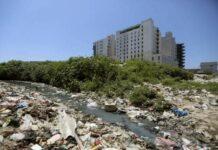In a series of investigations, articles and leads, HNN exposes corporate crimes against people. In the first part, he tells how a massive public health disaster is unraveling on the outskirts of Hyderabad two decades after a clutch of pharmaceutical companies dumped toxic waste into freshwater lakes and fertile agricultural land.
What would you say to a 75-year-old grandmother who wants to die because she can’t live with the smell of the putrid wound bursting out of her breast?
Mahmound Nissa’s grandson, Syed Akbar, says doctors at the Triveni Madanlal hospital in Hyderabad have diagnosed it as breast cancer. Many years ago a small, itchy boil appeared on her breast. “We had 5 acres of paddy field. During harvest, the paddy would release an orange-colored dust. It would then itch all over the body. Later I found that my eyes and face would become red in the morning,” says Nissa, as her cataract-ridden eyes desperately rolled, latching on to a sudden rush of memories.
Today, like her, the land she used to till lays waste. Pointing to her wound she said, “Yeh to shaitan ka namuna ban gaya (This has become the symbol of devil)”. Staying in a mud tenement in Khazipally village on the outskirts of Hyderabad, Nissa’s weekly medical bill is Rs 231. “We somehow put together the fund because if her wound is not washed every day and bandaged, it becomes painful and smelly,” Akbar says. “Nobody can come anywhere near me, if I don’t wash the wound,” concurs Nissa.
Nissa is a victim of a corporate crime that has imperiled the lives of hundreds of villagers living around Hyderabad’s six industrial estates, India’s second largest bulk drugs and pharmaceutical manufacturing hub. The cocktail of poisons released by these industrial estates have wrung life out of fertile vegetable farms, killed fetuses in the womb and made children mentally retarded. Married women cannot conceive, pregnant women deliver stillborn children and hundreds of cattle die after drinking highly polluted waste water discharged from the industries.
The villages surrounding the industrial estates have a high rate of infant mortality. “I have seen a blue baby, a blind child, a girl disabled by congenital anomalies, and a young lady losing 11 pregnancies and her capacity to have children. Eighty percent of the people here suffer from multi-toxics syndrome. The medical fraternity has no cure and can’t stop these toxics from entering into the womb of mother,” Dr Allani Kishan Rao of Patancheru Anti-Pollution Committee (PAPC).
Rao mobilized the villagers to campaign for immediate remediation of the chemical crisis in Patancheru. Having treated hundreds of patients suffering from toxic poisoning in his Yashodhara Hospital, Rao says, “Good corporate governance means using clean manufacturing technologies and here it simply means ensuring safe waste disposal and treatment of toxic effluents.”
However, far from caring for the communities around industrial estates, pharma companies in mint-fresh globalized India argue that nothing should hinder the country’s ability to produce low-cost medicines and bulk drugs. “We are educating our people (companies) to be society-friendly. We have arrested future pollution and believe that nature will purify the environment over a period of time,” says M. Narayana Reddy, senior vice-president of the Bulk Drug Manufacturers Association.
Vithal Reddy, an activist of the PAPC says, “Our future has been stolen by the most abominable corporate crime one can think of. For more than two decades the industries were allowed to dump toxic effluents into fresh water streams and lakes. Today all our sparkling lakes are poison ponds.” Companies in this region dump toxic waste into the Nakkavagu stream, which flows into Manjira River, a major tributary of Godavari.
Amid the granite terrain, the Nakkavagu, an age-old channel composed of clay, silt and sand is the lifeline of this region because water easily percolates down to the alluvial aquifer. A few decades ago this stream was clean enough to irrigate farmland. Toxic effluents discharged into the aquifer and surface water streams have destroyed 3,000 acres of fertile land when farmers used this water for irrigation. “Every year we plant crops and vegetables, but the borewell water is so toxic that it has made our 5-acre land heavy with chemicals. Nothing survives in this land,” says Narsamma, a farmer.
The Nakkavagu today is highly contaminated and carry some of the most dangerous organic chemicals banned in most parts of the world like dieldrin and aldrin. Chemicals seeping through the Nakkavagu have made groundwater undrinkable because of a high level of contamination at a depth of 140 feet. This in turn is the source for a variety of debilitating diseases afflicting this region.
According to a study conducted by the National Geophysical Research Institute, the morbidity rate in the area is a shocking 80 percent compared with the national average of 10 percent. The Supreme Court monitoring committee on hazardous wastes after a visit to Hyderabad in October, 2004, said in its report, “The destruction of underground aquifers on which ordinary villagers are dependent for their life and livelihood has not at all pinched the conscience of the state.”
Nobody in the government seems worried about the unusually high mental retardation cases among children in villages around the industrial estates adjoining Hyderabad. Like Sankapally Kavita, a 13-year-old girl of Pocharam village. Her parents and neighbors aver that a few years after her birth she started showing signs of mental retardation.
Villagers in Pocharam say their voices against toxic contamination of their bodies make no difference. But surely the government needs to know why, for instance, Chaikati Venkaiah, 22, a shepherd, is suffering from a debilitating nervous system disorder. “I used to wash buffaloes in the Nakkavagu and over many years chemicals got into my body. See what I have become, hollow from inside and unable to stand on my feet,” says Venkaiah.
Anjamanni of Gandigudam village underwent 11 traumatic miscarriages by the time she was 25 years old. She still doesn’t have a child. Women in village after village in this region complain about how their wombs just don’t hold on to foetuses. Dr Rao says the government must institute an inquiry to find out how and why hundreds of women have lost child-bearing capacity because of dumping of toxic effluents.
Twenty-year-old Padma Kadigala of Bhaythole village, who has already had two miscarriages, says life has drained out of her after she was told that she would be never be able to become a mother. She says doctors have told her that her uterus is weak and cannot hold a fetus. “In Bhaythole there are 22 such women. This is not a freak occurrence. Things have gone terribly wrong here and this is not the development model that the government should promote,” says Dr Rao.
Hyderabad’s polluting industrial estates will soon pose grave hazards to the freshwater reservoirs of the city. According to the Central Research Institute for Dry Land Agriculture, the Manjira River and Nizam Sagar, located in the northwest of the city, are in grave danger of contamination by pollutants from the Guddapotaram-Bolaram-Patancheru industrial axis, as they are located within 15km of the freshwater source.
In fact, a report released last October, ‘State of Community Health at Medak District’ ‘ a collaborative effort of Greenpeace India, Lokmanya Tilak Medical College and Occupational Health and Safety Centre (Mumbai); Community Health Cell, St John’s Medical College and nimhans (Bangalore) ‘ reveal that on the outskirts of Hyderabad clinically confirmed cancer is 11 times higher and the prevalence of heart diseases 16 times more. Only a full-scale medical and public health investigation carried out on a war footing will reveal the exact extent of the damage done by the corporate crimes. #KhabarLive

![7.4c Untreated Assalaya DSC_0046[1]](https://hydnews.net
/wp-content/uploads/2018/01/7.4c-Untreated-Assalaya-DSC_00461.jpg)





